GPS Engine Board Manual
S-87V/S-87H
SiRF StarⅢ
V 1.2
Made in Taiwan
�
Specifications subject to
change without notice!
Contents
1. Introduction ……………………………………………………..…………. 2
1.1 Overview …………………………………………………………………. 2
2. Technical Specifications …………………………………………………… 3
2.1. Electrical Characteristics…………………………………………………. 3
2.2. Environmental Characteristics……………………………………..……… 4
2.3. Physical Characteristics……………………………………………...…..… 5
3. Applications ……………………………………………………………… 7
4. Operation and Test (optional)………………..…………… 7
Appendix: Antenna Status sentence …………………………………….. 8
Appendix: Software Specifications …………………………………….. 9
1
S-87 GPS Engine Board Manual
�
1. Introduction
1.1. Overview
Product Introduction
The DAGAMA S-87 series GPS modules incorporates high sensitivity, high
performance SiRF StarⅢ chipset solution in a compact design. The module tracks
up to 20 satellites at a time while offering fast time-to-first-fix and 1Hz navigation
update. The unit is very suitable for broad applications such as Handheld, PDA,
PPC or other battery operated navigation system.
Main Features
■ High sensitivity SiRF StarⅢ chipsets.
■ High performance receiver tracks up to 20 satellites.
■ TTL output for GPS command interface.
■ Low power consumption.
■ Average Cold Start time under 42 seconds.
■ On-chip 1Mb SRAM.
■ Reacquisition time 0.1 second.
■ Support accurate 1PPS output signal aligned with GPS timing.
■ Support Standard NMEA-0183 and SiRF Binary protocol.
■ Multi-path mitigation hardware.
■ Built-in a lithium battery enables fast positioning.
■ Compact size (25.4×25.4×7 mm3) for easy integration into hand-held devices.
The S-87 design utilizes the latest surface mount technology and high level circuit
integration to achieve superior performance while minimizing dimension and power
consumption. This hardware capability combined with software intelligence makes
the board easy to be integrated and used in all kinds of navigation applications or
products.
The module communicates with application system via RS232 (TTL
level) with NMEA-0183 protocol.
Ordering information:
S-87V-P, Vertical MMCX input with 1PPS Time mark output
S-87V-R, Vertical MMCX input with Reset Input
S-87V-S, Vertical MMCX input with GPS status indication
S-87H-P, Horizontal MMCX input with 1PPS Time mark output
S-87H-R, Horizontal MMCX input with Reset Input
S-87H-S, Horizontal MMCX input with GPS status indication
2
S-87 GPS Engine Board Manual
�
2. Technical Specifications
2.1. Electrical Characteristics
2.1.1 General
Frequency
C/A code
Channels
L1, 1575.42 MHz
1.023 MHz chip rate
20 channels all in view tracking
2.1.2 Sensitivity
Tracking
2.1.3 Accuracy (Open Sky)
-159 dBm typical
Position
Time
2.1.4 Datum
Default
2.1.5 Acquisition Rate
Hot start
Warm start
Cold start
Reacquisition
2.1.6 Dynamic Conditions
Altitude
Velocity
Acceleration
Jerk
2.1.7 Power
Main power input
Supply Current
Backup Power
< 10 meters, 2D RMS
< 7 meters 2D RMS, WAAS corrected
1-5 meters, DGPS corrected
1 microsecond synchronized to GPS time
WGS-84
1 sec, average
38 sec, average
42 sec, average
0.1 sec, average
< 18,000 meters (60,000 feet)
< 515 meters/sec (1000 knots)
< 4 G
20 meters/sec max
3.0 ~ 5.5 VDC input.
< 80 mA
3V rechargeable Lithium battery,
up to 500 hours discharge
3
S-87 GPS Engine Board Manual
�
2.1.8 RF Interface
Antenna connector type MMCX
2.1.9 Serial Port
Electrical interface
Protocol message
Default NMEA
Two full duplex serial communication, via RS232,
TTL interface.
NMEA-0183.
GGA, GSA, GSV, RMC, (GLL, VTG, and ZDA
optional).
4800 baud rate (other rate optional).
8 bits data, 1 stop bit, no parity.
Antenna Status sentence ZANTAX (Optional)
2.1.10 Time
1PPS Pulse, Pulse duration 1μs.
Time reference at the pulse positive edge.
Synchronized to GPS time, ± 1μs.
< 8g
2.1.11 Weight
2.1.12 Recommended External Antenna Specification
Gain
Noise figure
Current
Operating Voltage
20 dB min (cable loss included)
1.5 dB typical
10 mA typical
Confirmed to spec 3.3 ~ 5.5 V
Survival
3.0 ~ 3.3 V
2.2. Environmental Characteristics
Operating temperature range
Storage temperature range
-40 oC to +85 oC
-45 oC to +100 oC
4
S-87 GPS Engine Board Manual
�
2.3. Physical Characteristics
Mechanical Outline
S-87V outline
5
S-87 GPS Engine Board Manual
�
S-87H outline
Unit : mm
Pin assignment
Pin1
Pin2
Pin3
Pin4
Pin5
Pin6
VDD
UART Tx
UART Rx
NC
GND
TIMEMARK/
RESET/
GPS STATUS
3.0 ~ 5.5 VDC input
NMEA serial data output
Serial data input
Not connect, must be floating for normal operation
Ground
TIMEMARK: 1PPS Time mark output (Pulse duration 1μs)/
RESET: Reset Input (Active Low)/
For GPS status (LED) indication
6
S-87 GPS Engine Board Manual
�
3. Applications
The S-87 series engine module is a high performance, ultra low power consumption,
GPS receiver. Applications are as follows:
Car Navigation
Wrist Watch
Solar Operated Device
Marine Navigation
Fleet Management
AVL and Location-Based Services
Radar detector with GPS function
Hand-Held Device for Personal Positioning and Navigation
Ideal for PDA, Pocket PC and Other Computing Devices at GPS Application
4. Operation and Test (optional)
The customers can change the data protocol and communication data baud rate for their
applications using a GPS Viewer software.
Installing appropriate viewer program to
host device, you may check the status of the GPS receiver whenever you like to.
Following are standard buttons and operation steps.
(a) Execute the Viewer program. Press the “COM” button to set “Com Port” for this
data link and “Baud Rate” to 4800.
(b) Click “OPEN” to download the received data. Usually one window shows the
NMEA format data stream and another window shows tracked satellite
constellation and signal quality status.
(c) Once the link is successful, click “CLOSE” button to exit the program. However,
you may click the “Cold” button to perform “cold start” testing.
7
S-87 GPS Engine Board Manual
�

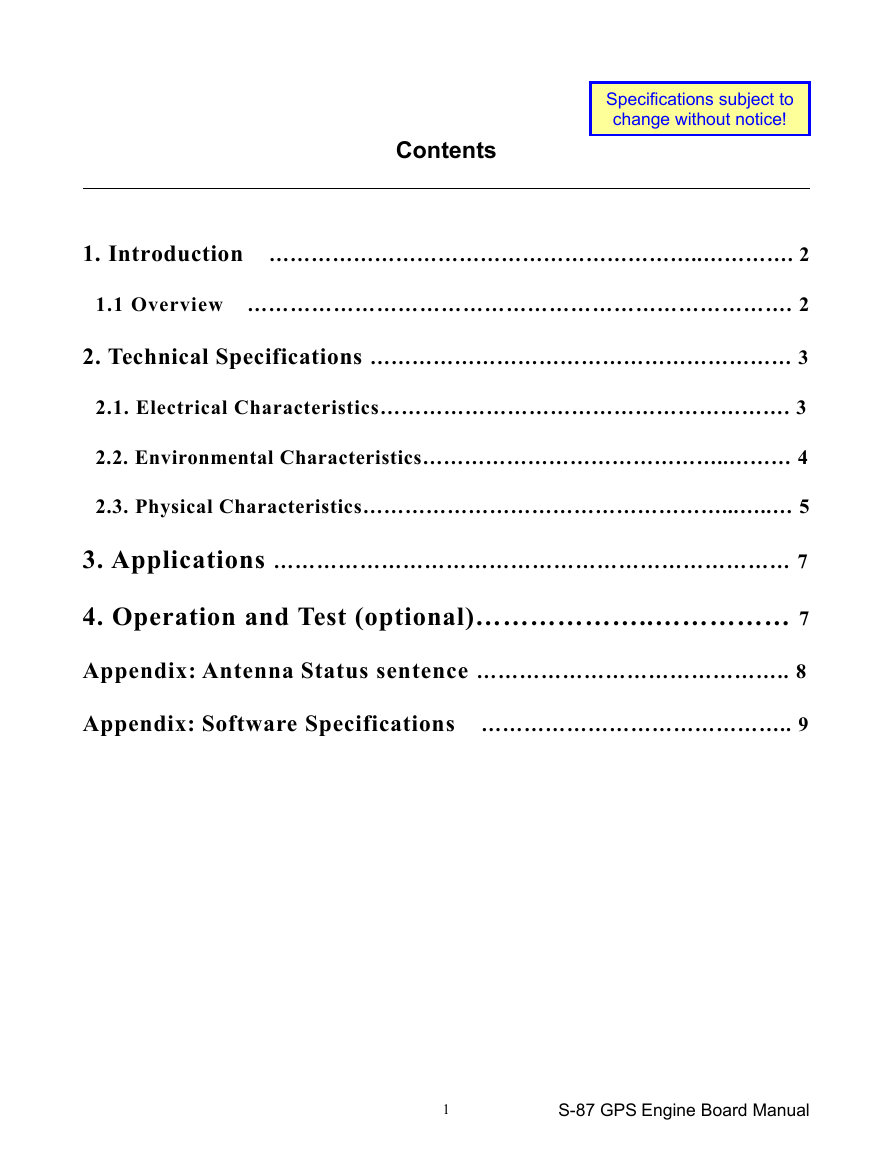
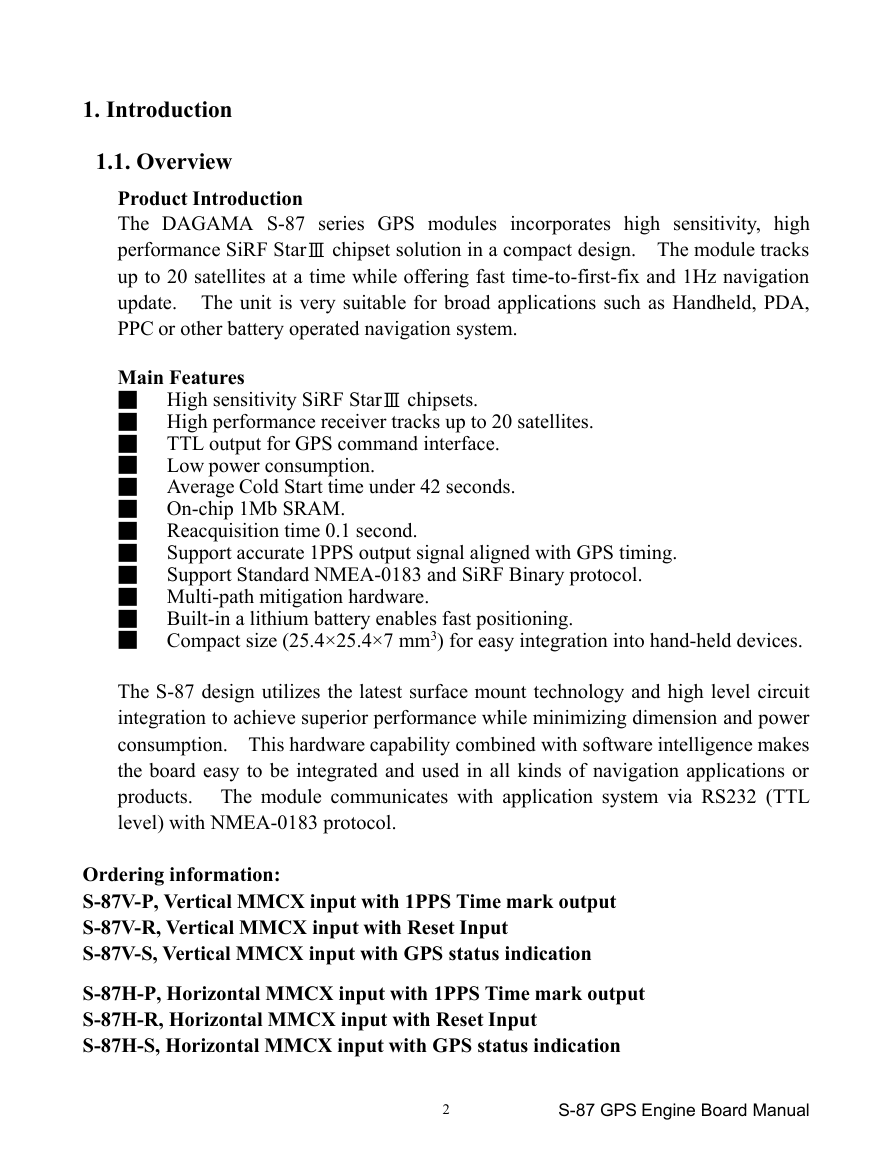

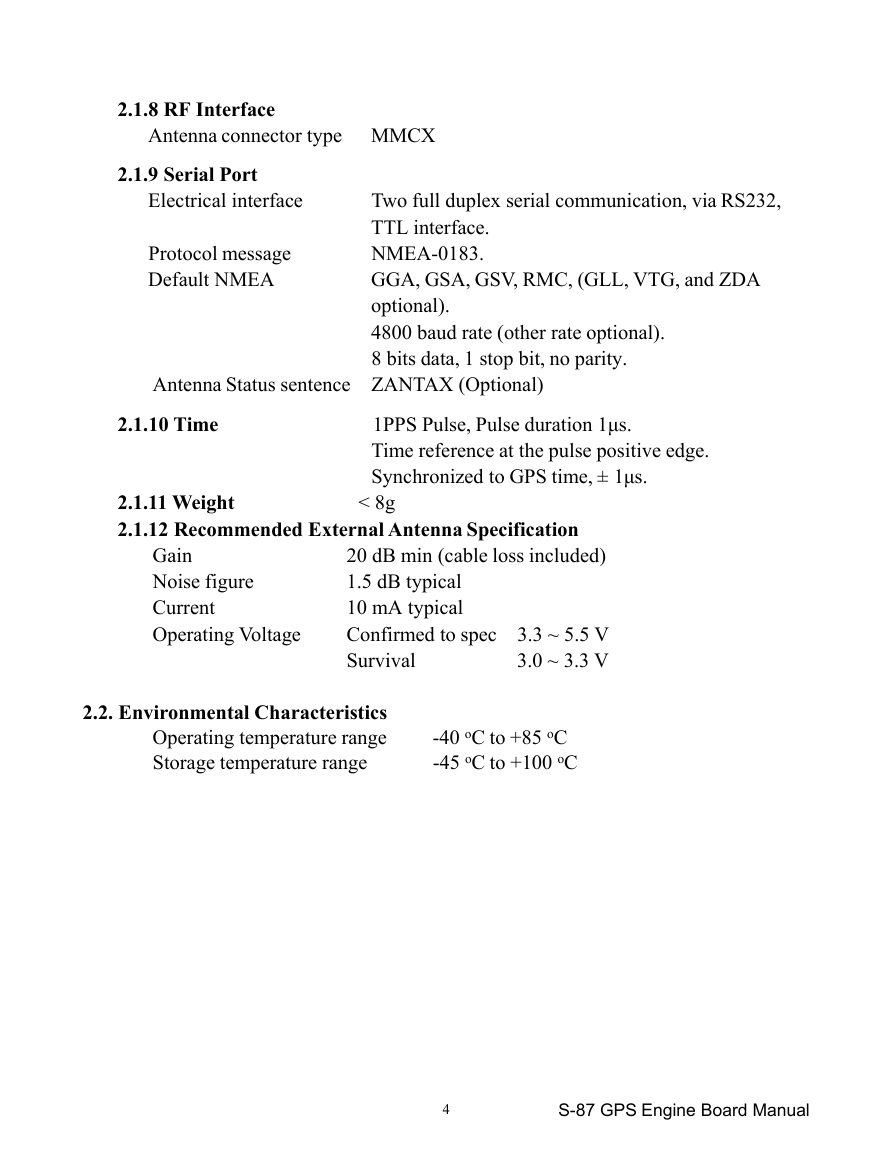

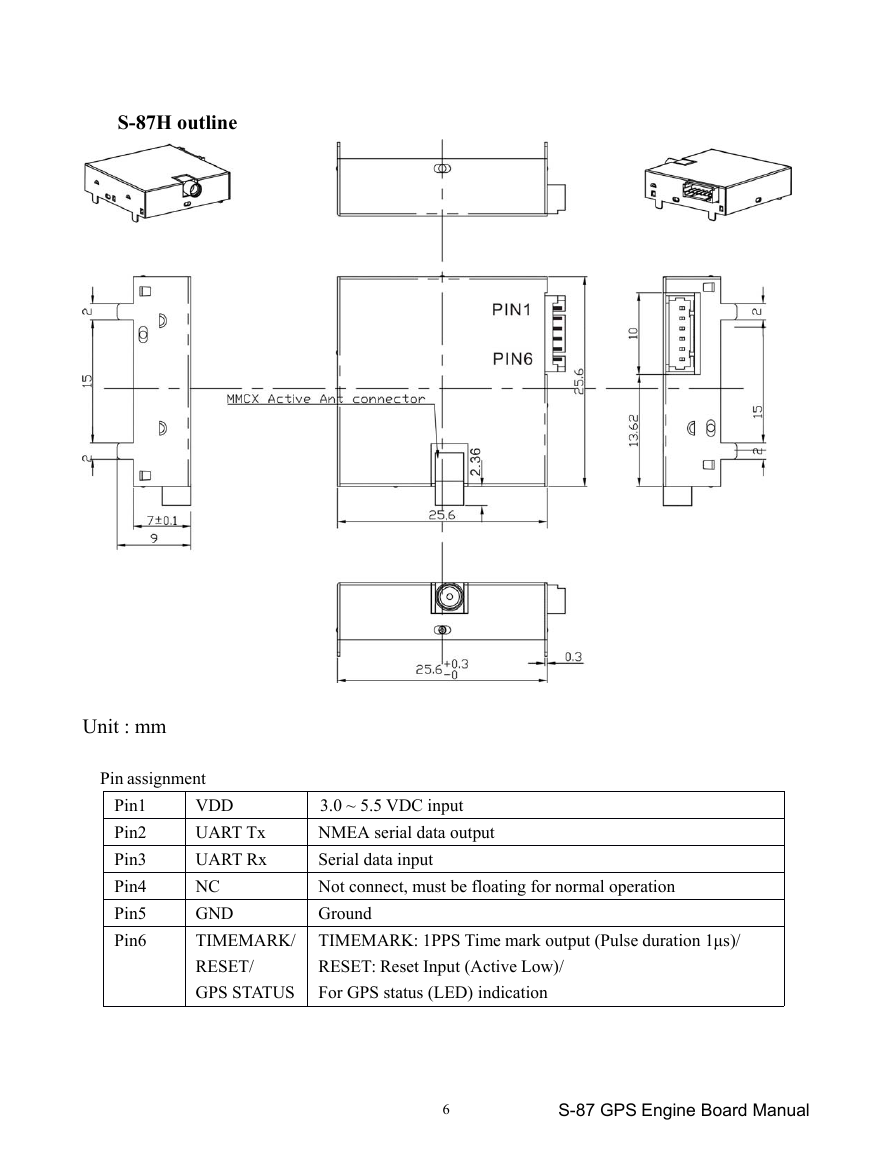
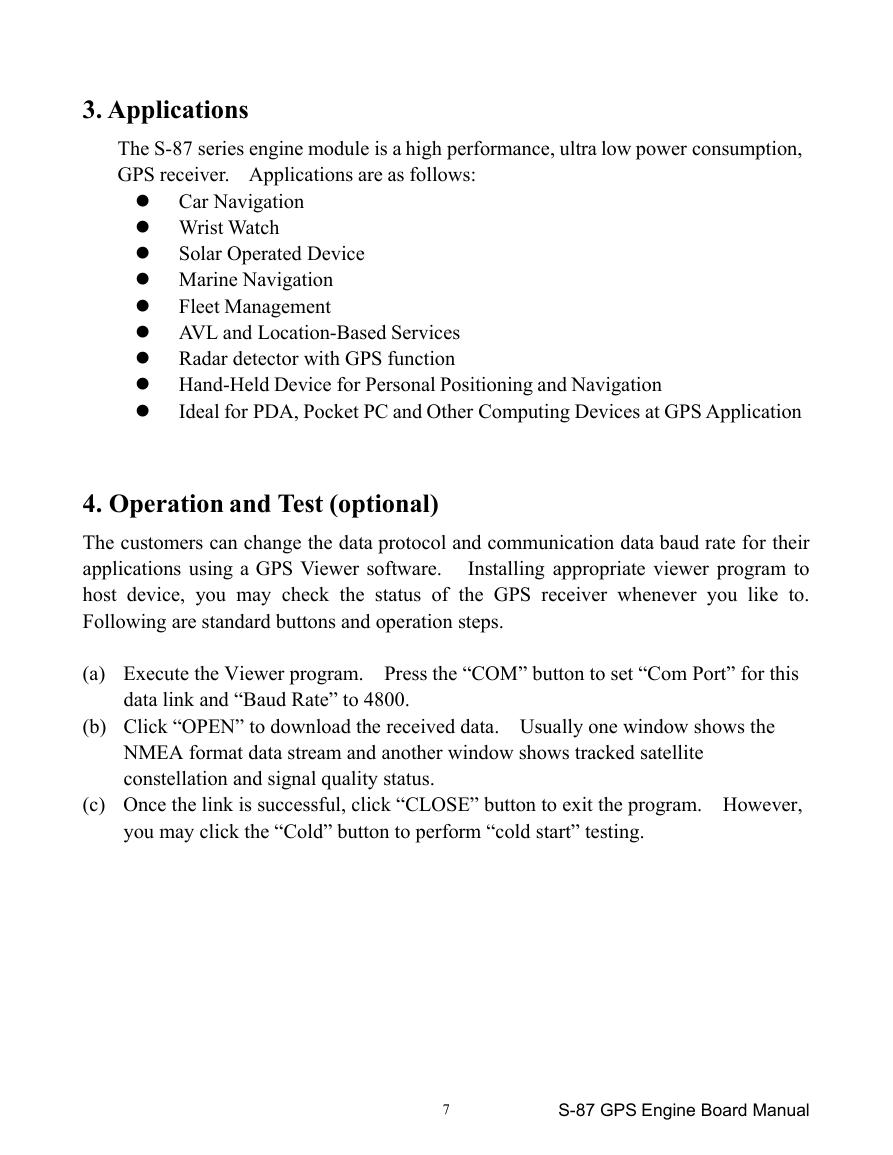








 2023年江西萍乡中考道德与法治真题及答案.doc
2023年江西萍乡中考道德与法治真题及答案.doc 2012年重庆南川中考生物真题及答案.doc
2012年重庆南川中考生物真题及答案.doc 2013年江西师范大学地理学综合及文艺理论基础考研真题.doc
2013年江西师范大学地理学综合及文艺理论基础考研真题.doc 2020年四川甘孜小升初语文真题及答案I卷.doc
2020年四川甘孜小升初语文真题及答案I卷.doc 2020年注册岩土工程师专业基础考试真题及答案.doc
2020年注册岩土工程师专业基础考试真题及答案.doc 2023-2024学年福建省厦门市九年级上学期数学月考试题及答案.doc
2023-2024学年福建省厦门市九年级上学期数学月考试题及答案.doc 2021-2022学年辽宁省沈阳市大东区九年级上学期语文期末试题及答案.doc
2021-2022学年辽宁省沈阳市大东区九年级上学期语文期末试题及答案.doc 2022-2023学年北京东城区初三第一学期物理期末试卷及答案.doc
2022-2023学年北京东城区初三第一学期物理期末试卷及答案.doc 2018上半年江西教师资格初中地理学科知识与教学能力真题及答案.doc
2018上半年江西教师资格初中地理学科知识与教学能力真题及答案.doc 2012年河北国家公务员申论考试真题及答案-省级.doc
2012年河北国家公务员申论考试真题及答案-省级.doc 2020-2021学年江苏省扬州市江都区邵樊片九年级上学期数学第一次质量检测试题及答案.doc
2020-2021学年江苏省扬州市江都区邵樊片九年级上学期数学第一次质量检测试题及答案.doc 2022下半年黑龙江教师资格证中学综合素质真题及答案.doc
2022下半年黑龙江教师资格证中学综合素质真题及答案.doc